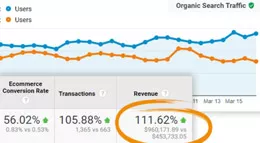How To Reduce Amazon eCommerce Cannibalism
While most businesses aren’t big enough to challenge the retail giant directly, successful companies will work with Amazon to list their products and attract customers through the marketplace’s brand. With careful planning, Amazon can be a partner, not a competitor. Here’s how you can avoid Amazon eCommerce cannibalism, create space for your brand in the SERPs, and still work with Amazon as a valued marketplace partner.

Most eCommerce Brands Are Affected by Amazon
Your company isn’t the first to feel overwhelmed by Amazon’s power, and it won’t be the last. Not only does Amazon have well over two billion visitors per day, but it also has a higher conversion rate than most online businesses. Amazon Prime members convert an average of 74% of the time, compared to 10-15% for non-Prime members. If 15% seems low, consider the fact that the average website’s conversion rate is 2.35 to 5.31%. Most retailers would love a 15% conversion rate.
Amazon certainly offers a boon to sales for those who advertise their products on Amazon Marketplace, but these listings can also cannibalize your own marketing efforts. In some cases, your Amazon listings will rank above your eCommerce site, or the duplicate content on both pages will push your pages below where you would like.
User Popularity Boosts Amazon’s Organic Rankings
High traffic levels, website behavior and conversion rates signal to Google that listing Amazon pages in the SERPs is the safe bet. The odds are in Google’s favor that customers will find what they want and trust the search engine to provide the best results.
Some retailers see Amazon as such a threat that they pull their listings from the marketplace, thinking they are knocking out the competition. Unfortunately, this logic isn’t sound. While Amazon listings might cut into your gross margin, they also boost your sales more than you could on your own. These listings also give your products more real estate than they would otherwise have if they were just on your eCommerce site.
The key to success is to develop an SEO strategy that shows your brand alongside Amazon’s listings and convinces people to check out your main website along with Amazon’s marketplace. You can’t fully prevent Amazon eCommerce cannibalism, but you can limit it with a little strategy.
Three Ways to Prevent Amazon eCommerce Cannibalism
You don’t have to give up your results entirely to Amazon, and you don’t have to pull your products from all marketplaces so you can show up in the SERPs. These three SEO tactics will take more work than simply letting Amazon take over, but they can boost your traffic, rankings and sales in the long run.
It’s Possible for Your Brand to Outrank Amazon
You won’t always beat Amazon in the SERPs, and your customers won’t always choose your brand over one of the top online marketplaces, but you can set yourself up for success by following these steps. Over time, you should be able to reduce your Amazon eCommerce cannibalism levels as much as any retailer can.


